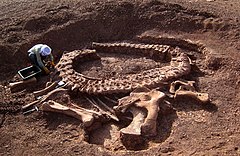Spinophorosaurus
Spinophorosaurus nigerensis
| Règne | Animalia |
|---|---|
| Embranchement | Chordata |
| Classe | Sauropsida |
| Sous-classe | Diapsida |
| Super-ordre | Dinosauria |
| Ordre | Saurischia |
| Sous-ordre | † Sauropodomorpha |
| Infra-ordre | † Sauropoda |
Spinophorosaurus est un genre éteint de dinosaures sauropodes basaux du Jurassique, retrouvé dans la formation géologique du groupe Irhazer, au Niger.
L'espèce type et seule espèce, Spinophorosaurus nigerensis, a été décrite par Kristian Remes (d) et ses collègues en 2009[1].
Description
[modifier | modifier le code]
Les os en blanc sont les os retrouvés.
La barre horizontale mesure 1 mètre.

L'étude de sa boîte crânienne montre que sa neuroanatomie est, d'une certaine manière, située à mi-chemin entre celle des Sauropodomorpha et celle des Neosauropoda[2]. Il était le genre type de la famille des Vulcanodontidae aujourd’hui considérée comme paraphylétique.
Il mesurait environ 13 mètres de long et pesait environ 7 tonnes[3],[4].
Classification
[modifier | modifier le code]Spinophorosaurus est placé, soit comme un sauropode très basal, en groupe frère du clade des eusauropodes par P. Martin Sander et ses collègues en 2011[5], soit comme appartenant à ce dernier groupe (L. Xing et ses collègues en 2015)[6].
Voir aussi
[modifier | modifier le code]Références taxinomiques
[modifier | modifier le code]- (en) Référence Paleobiology Database : Spinophorosaurus Remes et al., 2009
Annexes
[modifier | modifier le code]Articles connexes
[modifier | modifier le code]Notes et références
[modifier | modifier le code]Références
[modifier | modifier le code]- (en) K. Remes, F. Ortega, I. Fierro, U. Joger, R. Kosma et J.M.M. Ferrer, « A new basal sauropod dinosaur from the Middle Jurassic of Niger and the early evolution of sauropoda », PLoS ONE, vol. 4, no 9, , e6924 (PMID 19756139, PMCID 2737122, DOI 10.1371/journal.pone.0006924)
- (en) F. Knoll, L. M. Witmer, F. Ortega, R. C. Ridgely et D. Schwarz-Wings, « The Braincase of the Basal Sauropod Dinosaur Spinophorosaurus and 3D Reconstructions of the Cranial Endocast and Inner Ear », PLoS ONE, vol. 7, no 1, , e30060 (PMID 22272273, PMCID 3260197, DOI 10.1371/journal.pone.0030060)
- (en) Paul, G.S., 2010, The Princeton Field Guide to Dinosaurs, Princeton University Press p. 173
- (en) Holtz, Thomas R. Jr. (2011) Dinosaurs: The Most Complete, Up-to-Date Encyclopedia for Dinosaur Lovers of All Ages, Winter 2010 Appendix.
- (en) P. Martin Sander, Andreas Christian, Marcus Clauss, Regina Fechner, Carole T. Gee, Eva-Maria Griebeler, Hanns-Christian Gunga, Jürgen Hummel, Heinrich Mallison, Steven F. Perry, Holger Preuschoft, Oliver W. M. Rauhut, Kristian Remes, Thomas Tütken, Oliver Wings et Ulrich Witzel, « Biology of the sauropod dinosaurs: the evolution of gigantism », Biological Reviews, vol. 86, no 1, , p. 117–155 (ISSN 1464-7931, PMID 21251189, PMCID 3045712, DOI 10.1111/j.1469-185X.2010.00137.x)
- (en) L. Xing, T. Miyashita, J. Zhang, D. Li, Y. Te, T. Sekiya, F. Wang and P. J. Currie. 2015. A new sauropod dinosaur from the Late Jurassic of China and the diversity, distribution, and relationships of mamenchisaurids. Journal of Vertebrate Paleontology 35(1):e889701:1-17
